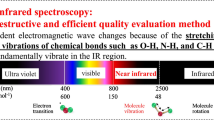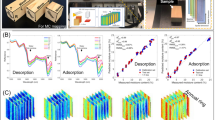Abstract
Many ecological studies rely heavily on chemical analysis of plant and animal tissues. Often, there is limited time and money to perform all the required analyses and this can result in less than ideal sampling schemes and poor levels of replication. Near infrared reflectance spectroscopy (NIRS) can relieve these constraints because it can provide quick, non-destructive and quantitative analyses of an enormous range of organic constituents of plant and animal tissues. Near infrared spectra depend on the number and type of CH, NH and OH bonds in the material being analyzed. The spectral features are then combined with reliable compositional or functional analyses of the material in a predictive statistical model. This model is then used to predict the composition of new or unknown samples. NIRS can be used to analyze some specific elements (indirectly – e.g., N as protein) or well-defined compounds (e.g., starch) or more complex, poorly defined attributes of substances (e.g., fiber, animal food intake) have also been successfully modeled with NIRS technology. The accuracy and precision of the reference values for the calibration data set in part determines the quality of the predictions made by NIRS. However, NIRS analyses are often more precise than standard laboratory assays. The use of NIRS is not restricted to the simple determination of quantities of known compounds, but can also be used to discriminate between complex mixtures and to identify important compounds affecting attributes of interest. Near infrared reflectance spectroscopy is widely accepted for compositional and functional analyses in agriculture and manufacturing but its utility has not yet been recognized by the majority of ecologists conducting similar analyses. This paper aims to stimulate interest in NIRS and to illustrate some of the enormous variety of uses to which it can be put. We emphasize that care must be taken in the calibration stage to prevent propagation of poor analytical work through NIRS, but, used properly, NIRS offers ecologists enormous analytical power.
Similar content being viewed by others
Author information
Authors and Affiliations
Additional information
Received: 10 October 1997 / Accepted: 12 May 1998
Rights and permissions
About this article
Cite this article
Foley, W., McIlwee, A., Lawler, I. et al. Ecological applications of near infrared reflectance spectroscopy – a tool for rapid, cost-effective prediction of the composition of plant and animal tissues and aspects of animal performance. Oecologia 116, 293–305 (1998). https://doi.org/10.1007/s004420050591
Issue Date:
DOI: https://doi.org/10.1007/s004420050591




